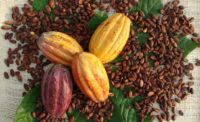By every measure, the Sanders Candy sea salt caramel confections introduced several years ago proved to be a huge success with wholesalers, retailers, and the public. These small-batch kettle cooked caramels — both milk and dark chocolate — quickly became one of the company’s top selling confections.
Beginning in early 2016, Sanders extended the caramel sea salt line to include mini bites — bite-sized pieces — for the grab-and-go segment of the market. Sanders packaged the sea salt mini bites in attractive 3.5-oz. stand-up pouches with each type of mini bite having its own color-coded packaging.
Pouch graphics were designed to catch the eye of the consumer with bold colors, a prominent illustration showing mouth-watering caramel, and a historic image of Sanders employees hand-crafting candy to convey the Sanders tradition of small batch confections.
To add to the mini bite line, Sanders developed a third confection – milk chocolate peanut butter caramel. Following introduction, mini bites sales climbed quickly. Success, however, brought challenges. Orders threatened to outpace the plant’s ability to cost effectively hand pack pre-made stand-up pouches. Sanders limited sales to its channel partners to ensure demand did not outstrip supply.
After months of preparation, Sanders automated the mini bites packaging line with an advanced high speed horizontal form/fill/seal (FFS) pouch machine. Line speed increased from 30 to 45 pouches per minute. The new automated machine is rated at up to 90 pouches per minute, offering capacity to expand in the future. The number of Sanders team members involved in pouch packing decreased from 13 hand packers to a single machine attendant.
Sanders no longer pays a premium for pre-made pouches but forms the packaging cost effectively from laminated-film roll stock. The speed and labor savings of high-speed automation made it possible to add two new confections to the mini bites line — dark chocolate peppermint patties and milk chocolate-covered gummi bears — for a total of five mini bite confections. And, the company boosted its marketing efforts because outstripping supply was no longer an issue.
Automating the pouch-forming line
Before the automation project began, it was clear that based on potential demand, 13 Sanders team members hand packing pre-made pouches was simply not a sustainable solution in terms of cost and output. High-speed automation was the only option. But what kind of automation? Laying down the objectives for the optimal solution, the production team outlined a wish list of key automation attributes.
- Increase productivity without compromising quality
- Give preference to form, fill, and seal solutions because of the lower material cost as well as the transportation and warehouse space saving advantages of laminated film in roll versus pre-made pouches. In addition, film also provides the benefit of faster time to market for new packaging
- The machine must be easy to operate and maintain
- Positive references from industry peers regarding machine quality and supplier training, tech support, and overall responsiveness to the customer’s needs
Another important capability would be continuous pouch machine operation per batch of mini bites with zero delay for film changeover from one roll to the next. Zero delay for film changeover was added to the wish list because there was no room for product accumulation on the proposed conveyors. No one wanted product overflowing the conveyors or the hassles involved in stopping the production line.
The Sanders team evaluated many machines while attending Pack Expo 2016; the FLtècnics FL 1.7 roll stock machine came closest to its set of goals. Fltècnics machines, manufactured in Spain, are exclusively sold and supported in North America by Matrix Packaging Machinery, a member of the ProMach family of brands.
Principally, the FL 1.7 offered an auto splice function for no downtime when rolls of film are automatically threaded, and it had the capability to add a re-sealable zipper, a must-have feature for consumer convenience. The quality of the ultra-clean design stainless-steel FL 1.7, the ease of accessing key components, and the intuitive interface impressed the Sanders team. Subsequent due diligence with references confirmed both the quality of the machine and Matrix responsiveness. The Sanders team ultimately purchased the show machine and had the factory add auto splice functionality.
The mini bites pouch filling line
Even with a plant comprising 72,000 sq. ft., the Clinton Township, Mich., manufacturing facility of Morley Candy Makers and Sanders Candy does not have much free floor space. The manufacturing team located an ideal space sufficient for the FL 1.7’s long narrow footprint more than 50 feet from the end of the mini bites cooling tunnel.
Best Industrial Group, Warren, Mich., designed and fabricated a bucket conveyor to lift the cooled mini bites approximately 15 feet above floor level and deposit product on a horizontal conveyor that outflowed product to a 14-head Yamato Dataweigh Advanced Alpha Scale ADW-A-03145. The Yamato combination weigher was selected for its quality and accuracy.
Following delivery of the pouch machine, service technicians from Matrix and Best Industry Group integrated the control of the conveyors and combination weigher with the pouch machine. The integration process went smoothly and quickly. Within three days of the start of the process, pouches of mini bites came off the packaging line.
Following the normal ramp up period where personnel became accustomed to operating and maintaining the new system, the plant began packaging all five confections of mini bites in the distinctive 3.75-oz., stand-up re-sealable pouches. Plans call for extending the mini bites line by packaging the confections in a larger stand-up pouch, which will be produced on the FL 1.7. The company may add a second FLtècnics machine for filling liquids in stand-up pouches on a new line.
From this and other experiences, it is clear that achieving anticipated return on investment depends on ensuring production can keep pace with the high-speed packaging line and that sales adequately supports increased output. Extensive reference checking lowers risk by determining whether the machine and supplier would be a good fit for the environment.
In addition to talking to management at a reference company prior to purchase, potential confectionery buyers should ask operators and maintenance personnel what their experience has been with the equipment under consideration.







